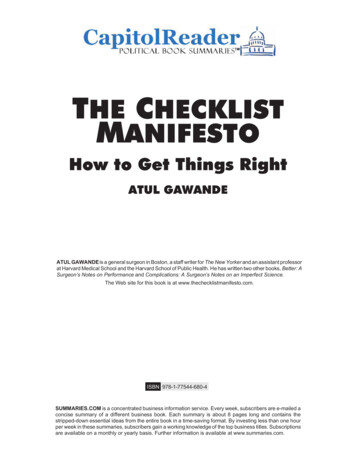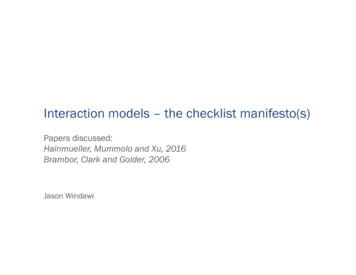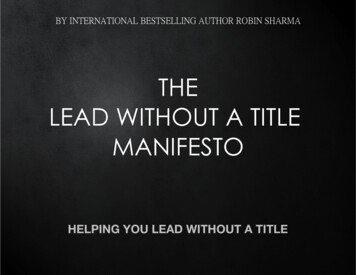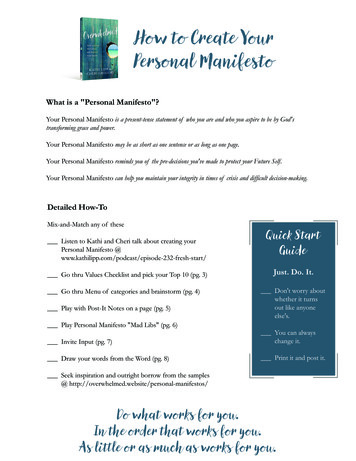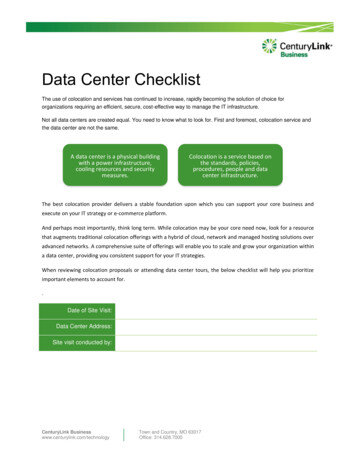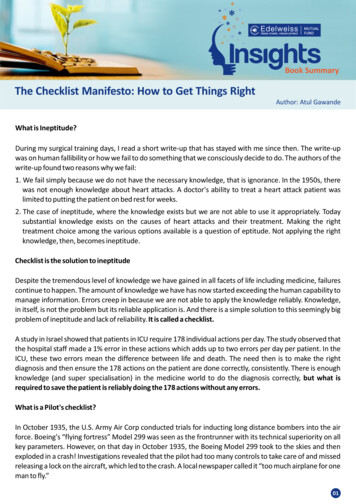
Transcription
Book SummaryThe Checklist Manifesto: How to Get Things RightAuthor: Atul GawandeWhat is Ineptitude?During my surgical training days, I read a short write-up that has stayed with me since then. The write-upwas on human fallibility or how we fail to do something that we consciously decide to do. The authors of thewrite-up found two reasons why we fail:1. We fail simply because we do not have the necessary knowledge, that is ignorance. In the 1950s, therewas not enough knowledge about heart attacks. A doctor's ability to treat a heart attack patient waslimited to putting the patient on bed rest for weeks.2. The case of ineptitude, where the knowledge exists but we are not able to use it appropriately. Todaysubstantial knowledge exists on the causes of heart attacks and their treatment. Making the righttreatment choice among the various options available is a question of eptitude. Not applying the rightknowledge, then, becomes ineptitude.Checklist is the solution to ineptitudeDespite the tremendous level of knowledge we have gained in all facets of life including medicine, failurescontinue to happen. The amount of knowledge we have has now started exceeding the human capability tomanage information. Errors creep in because we are not able to apply the knowledge reliably. Knowledge,in itself, is not the problem but its reliable application is. And there is a simple solution to this seemingly bigproblem of ineptitude and lack of reliability. It is called a checklist.A study in Israel showed that patients in ICU require 178 individual actions per day. The study observed thatthe hospital staff made a 1% error in these actions which adds up to two errors per day per patient. In theICU, these two errors mean the difference between life and death. The need then is to make the rightdiagnosis and then ensure the 178 actions on the patient are done correctly, consistently. There is enoughknowledge (and super specialisation) in the medicine world to do the diagnosis correctly, but what isrequired to save the patient is reliably doing the 178 actions without any errors.What is a Pilot's checklist?In October 1935, the U.S. Army Air Corp conducted trials for inducting long distance bombers into the airforce. Boeing's “flying fortress” Model 299 was seen as the frontrunner with its technical superiority on allkey parameters. However, on that day in October 1935, the Boeing Model 299 took to the skies and thenexploded in a crash! Investigations revealed that the pilot had too many controls to take care of and missedreleasing a lock on the aircraft, which led to the crash. A local newspaper called it “too much airplane for oneman to fly.”01
Book SummaryThe Checklist Manifesto: How to Get Things RightAuthor: Atul GawandeThe Army Air Corp went ahead with the much smaller Douglas bombers. Boeing test pilots went back to thedrawing board and came up with a solution that did not require additional training or tests. They puttogether a pilot's checklist that listed key checks for takeoff, flight, landing and taxiing. The pilots flew theModel 299 for 1.8 million miles without any mishap and the U.S. Air Force later bought 13000 aircrafts andrechristened them B-17. The B-17 played a critical role in the victory of the Second World War.Checklist in medicineIn the world of medicine, the belief is that the job is too complicated to be broken down into a simplechecklist. But that's not true. There are just four data points that indicate overall health of a patient-bodytemperature, blood pressure, pulse and respiratory rate. By recording these reliably and consistently, a lotof complications can be avoided. But then human memory fails to record all these four consistently andthen in a lot of cases, the overall complexity of the case makes this step “mundane and trivial” andtherefore, easy to miss. Checklists bring in the reliability of attention and the discipline of consistentbehaviour. Checklists act as a “cognitive net.”In 2001, Peter Pronovost, a critical care specialist at John Hopkins Hospital, put together a short checklist forone action in the ICU. There were five simple steps in this checklist like wash your hands, wear a mask and soon. He then made sure that the hospital administration authorised nurses to stop doctors if they skipped astep on the checklist. Over a period of one year of implementation, the infection rate went down from 11%to 0 %.Encouraged by this, Pronovost then tested some more checklists at the John Hopkins ICU with equallysuccessful results. However, the adoption of checklist was slow in John Hopkins partly because experiencedsurgeons got offended by the fact that they were being asked to follow a simple checklist, and partlybecause it was just one hospital.The Keystone InitiativeIn 2003, Pronovost got to test his checklist in a much more challenging environment at the Sinai-GraceHospital in Detroit. The Sinai Grace Hospital was big and struggling with funds and overall low employeemorale.Pronovost found that the hospital had one of the highest central line infection rates of all Americanhospitals. He also got a small bonus sanctioned for the hospital to participate in the program.This project, termed Keystone Initiative, led to a reduction of central line infection by 66% and over 1802
Book SummaryThe Checklist Manifesto: How to Get Things RightAuthor: Atul Gawandemonths, the Keystone Initiative helped save 1500 lives and 175 million. All due to the humble checklist.But do all situations require a checklist?The Three types of problemsExperts have succeeded in classifying all the problems in the world into 3 buckets!1. Simple problems like baking a cake require basic techniques to learn and with training and recipe,chances of success are high.2. Complicated problems are like launching a rocket. The process is not as simple as a cake recipe andrequires multiple sub projects and team coordination. Once a rocket is launched, then the process iscoded and repeated for other rockets.3. Complex problems like raising a child are more difficult than launching a rocket. That's because youcannot repeat the “process” of raising your first child for your second child. The second child may be verydifferent from the first and requires a very different “process”. The outcome remains highly uncertain.Checklist in construction industrySo do checklists work only for simple problems or across the spectrum of simple, complicated and complexproblems? I found my answer in the construction industry. How do construction workers know they areconstructing a building correctly? I spent some time with the structural engineer who was building our newhospital wing and got to understand the following:Construction workers follow a construction schedule that tracks individual sub projects, their dependenciesand the time taken. This schedule is almost like one long checklist.This construction schedule is sent to sub-contractors for a double-check and using this schedule, theknowledge of hundreds of engineers and construction workers is used in the right place at the right timeand in the right way.There is one more checklist called the submittal schedule- this checklist did not list construction tasks likethe construction schedule and instead, listed the communication tasks. The submittal schedule ensureddifferent teams talked to each other as per a schedule with defined frequency and discussion subject. Thesubmittal schedule combines the power of communication with the wisdom of the group.Today these two schedules are managed using sophisticated software but in the days before the computer,there would be a master builder who would act as the central flow for both construction and submittal03
Book SummaryThe Checklist Manifesto: How to Get Things RightAuthor: Atul Gawandechecklists.The construction industry had realised long ago, and much before medicine folks, that the knowledgerequired to build a skyscraper exceeds any one individual's knowledge and multiple teams leads tocomplexity. By having the two checklists the construction industry had tackled unpredictability and yetmade room for judgement of the experts.Van Halen's brown M&M candyCelebrated rock group Van Halen has an interesting clause in its contract with concert promoters-there willbe bowls of M&M candies kept at the backstage but none of the bowls will contain the brown variant ofthe candy. If a brown M&M is found, Van Halen will not perform and the organisers have pay the group thefull contract amount. The only way to remove brown candies from a pack of M&Ms is to manually removethem!David Lee Roth of Van Halen explained this clause in his memoir Crazy from the Heat. He said he did this toensure that the complexity of a Van Halen concert involving tonnes of material and heavy duty trucks doesnot make the concert organisers skimp corners. In one instance in Colorado, when Van Halen discoveredbrown candies in their M&Ms, they did a full check of the arrangements and discovered that the organisershad not complied with the weight requirements and there was a risk that the entire stage would havecollapsed under its own weight.Van Halen cancelled the concert because they found brown M&Ms and then they found serious safety risk.Van Halen had a checklist!Project in PakistanThe three features (simple, measurable, transmissible) are best captured in a public health programconducted in Pakistan with U.S. support in late 1990s. The program was aimed at reducing the high rate ofpremature death among children in the slums of Karachi, Pakistan. The slums suffered from inadequatesewage systems & illiteracy coupled with a corrupt bureaucracy.A young American health worker Stephen Luby was part of the program and he decided to use the humblesoap to achieve the program objective. His team, with some help from P&G, distributed soaps across theslums asking people to wash with soap in six situations daily, ranging from taking bath to before preparingand eating food. The slums were divided into test (where soaps were distributed) and control (where nosoap was distributed) zones.04
Book SummaryThe Checklist Manifesto: How to Get Things RightAuthor: Atul GawandeThe program continued for a year and the results were staggering-diarrhoea incidents dropped by 52%compared to control zones and pneumonia went down by 48%. Luby explained the success in terms ofsoap being a behaviour change agent.Even before the study, in both the test and control zones, people were using soap. Just that they were usingit infrequently and inconsistently. By providing free soap, the need to buy more soap due to more frequentwashing, was taken care of. Secondly, the six situations for using soap and its communication made the useof soap more systematic. This provided the consistency and reliability that is critical for success. Effectively,Luby had got the test zone slum dwellers follow a six point checklist on using soap!Checklists at the WHOIn January 2007, on a request from the World Health Organisation (WHO), I took up a project spanning allmember WHO countries, aimed at reducing avoidable deaths from surgery. During our first meeting inGeneva, various approaches to reduce these avoidable deaths were discussed, including more training andincentivisation as well as publishing a manual for official standards for safe surgical care. But then therewere scores of manuals lying hospitals across the world unread. We needed something more effective andyet simple, measurable and transmissible-the three things required for effective implementation.The joint team at Geneva decided to test a safe surgery checklist. This checklist had three “pause points”before anaesthesia, after anaesthesia but before incision and then at the end of the surgery before thepatient is wheeled out of the operation theatre. The communications check (akin to construction industry'ssubmittal schedule) was also incorporated.We were all very excited to implement this checklist across the world and I decided to use it in my operatingroom as well. However, the checklist in my operating room did not stand up to scrutiny and led to delays inthe surgery. The checklist did not survive one operating room in America, leave alone the rest of theworld. I then decided to understand more about making checklists from the folks who had pioneered it andwere using it for the past 8 decades-the aviation folks.Checklist and aeroplanesI met up Daniel Boorman of the Boeing Company at Seattle. Daniel showed me a 200 pages boundhandbook that pilots use. Surely the checklist could not be 200 pages long? Daniel clarified that it wasactually a compilation of various checklists built for a variety of flight scenarios. The normal checklist thatwas used for day to day flight operations was only three pages, each page having just a couple of lines in easyto read font. I learnt that good checklists are brief and precise. Bad checklists are confusing and try to05
Book SummaryThe Checklist Manifesto: How to Get Things RightAuthor: Atul Gawandecapture so many things that they start resembling how-to-do manuals.Aviation uses two kinds of checklists. The DO-CONFIRM checklist requires people to do their jobs and thenpause and run the checklist to confirm everything required was done. The READ-DO checklist, on the otherhand, is more like a recipe-you read the checklist and do things as instructed. Pilots repeatedly andconsistently use checklists because they have been trained to use checklists and also because they areaware of the benefits of using checklist.Back at the WHOI went back to my WHO Geneva team armed with this knowledge and we decided to modify our safe surgerychecklist into a DO-CONFIRM checklist. This format gave the expert surgeons enough flexibility to do thingstheir own way and yet ensure they paused at the relevant stages to confirm what needs to be done.In spring 2007, all the participating countries again convened in London to discuss the checklist. The finalchecklist had 19 actions and 3 pause points- seven points before anaesthesia, seven points before incisionand five points before leaving the operating room. Armed with this, in spring 2008, the WHO program wasrolled out in hospitals across eight countries in the developed, developing and under developed worlds.The results of this WHO pilot came in October 2008. Across the eight hospitals, surgical complicationsdropped by 36% and deaths due to surgery dropped by 47%. Our detailed findings were published inJanuary 2009 and the word caught on beyond the pilot hospitals and countries. After three months of thechecklist being in place, we did a spot survey and found that 80% of the staff found the checklist quick andeasy to use and 78% actually observed that the checklist had prevented an error during the surgery.Checklist in financeChecklists are not just about medicine, construction and aviation sectors. They are equally effective even inthe esoteric world of finance. Warren Buffet apparently uses a “mental checklist” when he evaluatesinvestment proposals. I spoke with Mohnish Pabrai, managing partner at the 500 million PabraiInvestment Funds in California. Mohnish believes in systematic investigation before deciding to invest andunlike Warren Buffet, he has a written checklist that he ensures his team uses every time.In a study by Geoff Smart at Claremont Graduate University, 51 venture capitalists were observed goingabout their daily job of identifying the right investment to put their money in. Smart identified six differentstyles these 51 smart people took decisions1. Art critics: they assessed their potential investments intuitively, like you would evaluate art06
Book SummaryThe Checklist Manifesto: How to Get Things RightAuthor: Atul Gawande2. Sponges: assessed their bets by gathering more information, “soaking” up via interviews and on-sitevisits.3. Prosecutors: evaluated their potential investments through aggressive and challenging interrogation4. Suitors: focussed more on wooing proposals than evaluating them5. Terminators: knew it all, skipped the evaluation bit and bought ideas that they believed in and firedentrepreneurs who did not toe their line6. Airline Captains: took a systematic checklist based approach, evaluating all information and ensuring thediscipline of checklist based evaluation for each and every prospect investment.Geoff Smart's study revealed that Airline Captain VCs had 80% median return on investments while othershad 35% or less. The likelihood of an Airlines Captain style VC firing the entrepreneur was 10%, compared to50% for others. However despite the apparent advantages, only one in eight VCs took the Airline Captainapproach.Flight 1549 on the HudsonChecklists are seen as effective yet boring. The Hero in us wants to take up a dare, a challenge-not go by aboring checklist. The world loves a hero.On January 15th 2009, US Airways Flight 1549 made an emergency landing in the Hudson River. CaptainSullenberger, who steered the 155 passengers into safety, was acknowledged as the hero all over the world.Repeatedly Sullenberger clarified in his interviews that it was a team effort. Investigation into this closeshave revealed that Sullenberger and his co-Captain went through their checklist as soon as the enginesmalfunctioned. They had never flown together before this flight but the communications briefing checklistwas adhered by these pilots, just like all pilots in aviation sector. This helped them work together to land theplane on Hudson in relative safety. Pilots know that checklists work.All professionals, irrespective of the sector, inherently work on three unwritten (or written) codesselflessness, high level of skill (competence) and trustworthiness. Pilots add a fourth dimension thatothers find difficult to inculcate-discipline.Humans are designed to be innovative, not disciplined-it needs to be worked upon. By incorporating thediscipline of following checklists for more than seven decades, many lives have been saved. This disciplineneeds to seep into other professions and our daily lives as well.You can read this and more than 100 life changing handcrafted book summaries on the bookbhook app. bookbhook.com is an initiative bytwo IIM-A alumni who are passionate about reading and learning, and are building solutions that reinvent reading. Please visitbookbhook.com to download the bookbhook app and to read the terms & conditions covering this book summary.07
The Checklist Manifesto: How to Get Things Right Author: Atul Gawande . The program continued for a year and the results were staggering-diarrhoea incidents dropped by 52% compared to control zones and pneumonia
